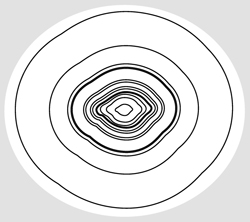![]()
FOR THOSE OF us living in more temperate climes, the occasional light hailstorm may elicit no more than surprise. But make no mistake – those lumps of ice that fall from the heavens can be a real hazard, shattering windscreens, causing damage to property and even leading to loss of life.
Hailstones start innocently enough as small ice crystals in cumulonimbus storm clouds. Unimaginably vast, these clouds can have a base at 600 metres (approx. 2,000 feet) but a top stretching to a height of 12,000 metres (40,000 feet) above ground, or even 18,000 metres (60,000 feet) in tropical areas.
In the turbulent inner world of the cumulonimbus, vigorous up- and down-draughts gather the tiny falling crystals and sweep them up, down and back up again. Inside the cloud, too, are supercooled water droplets that, despite the freezing temperatures, have not turned to ice because they have had nothing to adhere to in order to freeze – yet. Now’s their chance. As the droplets collide with the swirling ice crystals, they flow over them to form a new layer of ice. And they can do this again and again, creating bigger and bigger hailstones each time.
Generally, the larger the cumulonimbus, the stronger the updraughts and hence the bigger the hail. When the hailstones get too heavy to be swept up again, they finally fall to the ground.
DO IT YOURSELF!
It is possible to observe the formation of a hailstone by counting the number of layers of ice. Each layer represents a collision with a supercooled droplet. The opacity of each layer also tells you how quickly it froze: transparent ice means it froze slowly; opaque ice means it froze quickly, trapping air to make it less see-through.

In order to form, hail needs the strong updraughts and spin within a thundercloud so it is more common in parts of the world that are prone to severe storms. The largest storm clouds develop in the tropics so it is here that the biggest hailstones – often as large as golf balls – develop.
HIT THE GROUND RUNNING…
Hailstones are no slowcoaches – they can hit the ground at more than 144kph (90mph).
It’s no joke – hail can seriously damage your health. In some cases, it can even kill.
• In April 1996, hailstones weighing 1kg (2lb) each battered the Gopalganj district of Bangladesh, resulting in more than 90 deaths.
• In May 1996, a hailstorm in China killed around 100 people, injured 9,000 more and destroyed 35,000 homes.
• In April 1999, hailstones more than 8 centimetres (3 inches) wide clattered down on Sydney, Australia. For five hours and more the storm raged, damaging 40,000 vehicles and 20,000 buildings and other structures.
• In 2003, a hailstone 17.8 centimetres (7 inches) wide fell near Aurora, Nebraska.
• In the United States, hailstorms cause more damage than any other type of weather apart from severe storms, resulting in losses to agriculture alone of about $1 billion per year.